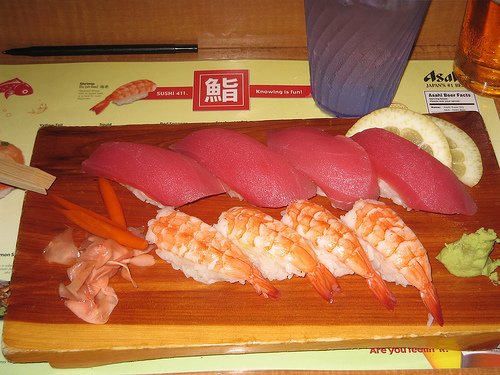It’s a boy! All Japan is currently cheering the news that Princess Kiko has given birth to a boy. The new royal son — the first male heir to be born in four decades — is third in line to succeed the current Emperor, Akihito, known in Japan as the Heisei Emperor, since that’s the name of the current era. The birth of a male heir ends the long controversy over whether Naruhito’s daughter Aiko would be allowed to fill the role as Empress. Japan has had eight females in that position in its long history, but none since the Meiji Restoration, in which Japan “restored” the role of the Emperor after 1300 years of being little more than a political figurehead. The new birth takes the pressure off poor Masako-sama, wife of the Crown Prince, who had fallen into depression over pressure from the Imperial Household Agency to get pregnant with a male heir.
I’ve got a Yankee friend who lives in Tokyo, and the other day he asked an odd question. “I forget, do Americans stand in a line, or in a queue?” Forgetting your own dialect of English might sound like a strange thing to have happen, but in a place like Japan where foreigners of all nationalities are grouped together into one big gaijin melting pot, little things like vocabulary and grammar can seem pretty unimportant. It’s quite common for gaijin to hang out with foreigners from other parts of the world, and I’ve been known to throw back a beer or two with friends from other countries — it’s fun to debate American politics with Canadians or Australians or Brits, since they’re emotionally divorced from the day-to-day political issues in the U.S. One word I accidentally picked up was “uni” (you-NEE), slang from down under that means university, but none of my friends back home knew what I was talking about when I used it. Part of the issue is the lack of native speakers around — it’s incredible how your own language changes when the social group around you changes. I suspect this phenomenon is not unrelated to how a person’s written grammar and punctuation goes to hell from hanging out in Internet chatrooms too long.
Recently, I went on eBay and found a copy of my very first Japanese textbook, Foundations of Japanese Language by Soga. Reading through this old book, which has been surpassed by much better works nowadays, left me totally natsukashii (NATS-ka-SHEE, translatable as “so nostalgic I look like one of those manga characters with a tear rolling out of my eye”). Looking back, I realize I went through several stages as I struggled to learn this wonderful, difficult language. First, I worked to master hiragana, the syllable-based writing system that looked like so many snakes squirming there on the page (snakes! on a page!). I went through a phase where I reduced sentences into mathematical equations, which allowed me to swap out elements to say what I wanted to say, and after that, a period of growing my vocabulary by reading manga and transcribing song lyrics for karaoke. After coming to Japan, I buckled down for more serious study, including the subtle art of keigo, the special subset of language used in polite situations. Invited to a Japanese friend’s house, I dediced to try my polite language with my host, but I messed it up so bad that he didn’t even understand what I said. I’d taken my shot and messed it up terribly, although I certainly learned from the experience. (Aside: I once saw a news conference where this happened to a foreign correspondent who had asked the Emperor a question…Akihito didn’t understand what he was asking, and I felt so bad for that poor reporter.)
In Japanese, the word nampa means to flirt with members of the opposite sex and try to take them home (apologies to our customers in Nampa, Idaho). Our newest wacky Japanese T-shirt aims to help break the ice between you and potential Japanese females by displaying a standard “eye chart” (as soon at doctor’s offices everywhere in Japan) that’s specially designed to help your nampa skills. The text on the eye chart essentially says “Hey, how are you doing? You look pretty good. Are you doing anything right now? If not, let’s go have some coffee together…” Since potential Japanese girls have to get up close and personal to read the small text, it’s an interesting secret weapon that can break down the barriers between you. This might lead to a beautiful relationship! Printed with high quality silkscreening for long life, on an 6.1 lb 100% cotton shirt (orange). Sizes S-XL are available.
Remember that J-List is your source for getting Japan’s best anime, manga, JPOP/JROCK, gothic fashion and other magazine, direct from Japan through our “reserve subscription” system. All magazines are chosen for high numbers of pictures and other visual elements, so even if you don’t read the language, there’s plenty of great information in each issue, with lots of cool color pictures and other stuff. In case you ever wondered, the top-selling magazines (based on current subscribers) are, Megami Magazine (great bishoujo girls and loads of posters); Goth-Loli Bible (the voice of gothic cosplay culture in the world); FRUiTs (Tokyo street fashion); Hiragana Times (with articles in both English and Japanese); Newtype Japan; Kera (gothic and “punk” fashion), SHOXX (J-Rock in the extreme); Cosmode (anime cosplay); Nihongo Journal (for learning Japanese); and Comic AG (our best-selling “H” manga). You never need to pay in advance and you can cancel your revolving subscription at any time. By the way, if there’s a magazine you’d love for us to carry, please suggest it to us!
















